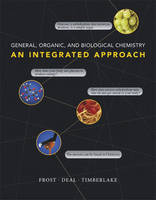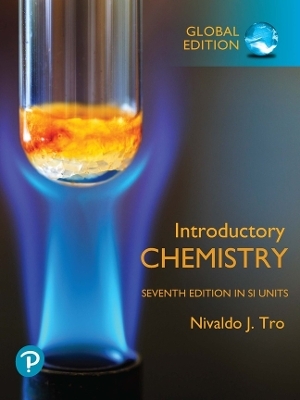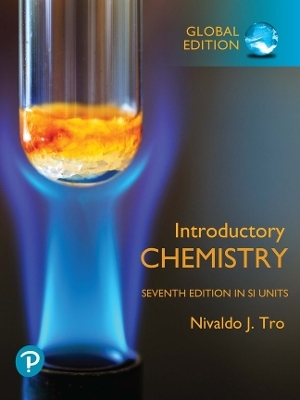
Pearson eText Student Access Kit for General, Organic, and Biological Chemistry
Pearson (Hersteller)
978-0-321-69798-1 (ISBN)
- Titel ist leider vergriffen;
keine Neuauflage - Artikel merken
Drawing on 20 years of teaching allied health and pre-professional students, authors Laura Frost and Todd Deal have created this innovative new text for your GOB chemistry course. General, organic, and biological chemistry topics are integrated throughout each chapter in a manner that immediately relates chemistry to your future allied health career and everyday life. General, Organic, and Biological Chemistry: An Integrated Approach introduces the problem-solving skills you will need to assess situations critically on the job. Unique guided-inquiry activities are incorporated after each chapter, guiding you through an exploration of the information to develop chemical concepts, and then apply the developed concept to further examples.
Laura D. Frost is an Associate Professor of Chemistry at Georgia Southern University, where she has taught chemistry to allied health students since 2000. She received her bachelor’s degree in chemistry from Kutztown University and a Ph.D. in chemistry with a biophysical focus from the University of Pennsylvania. Professor Frost is actively engaged in the teaching and learning of chemistry and uses a guided inquiry approach in her classes. Dr. Frost is a member of the American Chemical Society and its Chemical Education division and the Biophysical Society. In 2007, she was honored with the Regent’s Award for the Scholarship of Teaching and Learning by the University System of Georgia and was inducted into the Regent’s Hall of Fame for Teaching Excellence. She is an advocate for increased student learning in science, technology, engineering, and mathematics (STEM) disciplines using guided inquiry and has spoken at numerous conferences and workshops on this topic. Todd S. Deal received his B.S. degree in chemistry in 1986 from Georgia Southern College (now University) in Statesboro, Georgia, and his Ph.D. in chemistry in 1990 from The Ohio State University. He joined the faculty of his undergraduate alma mater in 1992, where he currently serves as Director of the Office of Student Leadership and Civic Engagement. Professor Deal has taught chemistry to allied health and preprofessional students for 20 years. In 1994, he was selected Professor of the Year by the students at Georgia Southern University. Professor Deal is also the recipient of the Allen E. Paulson College of Science and Technology’s Award for Excellence in Teaching (2003), the Georgia Southern University Award for Excellence in Contributions to Instruction (2003), and the Allen E. Paulson College of Science and Technology’s Award for Excellence in Service (2006). Karen Timberlake is Professor Emerita of chemistry at Los Angeles Valley College, where she taught chemistry for allied health and preparatory chemistry for 36 years. Professor Timberlake has been writing chemistry textbooks for 33 years. She is known for her strategic use of pedagogical tools that promote student success in chemistry and the application of chemistry to real-life situations. More than one million students have learned chemistry using texts, laboratory manuals, and study guides written by Karen Timberlake.
NOTE: Each chapter concludes with Summary, Key Terms, Important Equations, Additional Problems, Challenge Problems, Answers to Odd-Numbered Problems, and Looking Ahead.
Chapter 1: Chemistry: It’s All About “Stuff”
1.1 “Stuff” is Matter
1.2 Gas Behavior — An Introduction to the Behavior of Matter
1.3 Classifying Matter : Mixture or Pure Substance
1.4 Elements, Compounds, and the Periodic Table
1.5 How Matter Changes
Chapter 2: Atoms, Radioactivity, and Ions
2.1 The Atom and Subatomic Particles
2.2 Atomic Number and Mass Number
2.3 Isotopes and Atomic Mass
2.4 Measuring Atoms: The Mole
2.5 Electron Arrangements
2.6 Radioactivity and Radioisotopes
2.7 Nuclear Equations and Radioactive Decay
2.8 Radiation Units and Half-Lives
2.9 Medical Applications for Radioisotopes
Chapter 3: Compounds: Putting Particles Together
3.1 The Octet Rule
3.2 In Search of an Octet Part 1: Ion Formation
3.3 Ionic Compounds — Give and Take
3.4 In Search of an Octet Part 2: Covalent Bonding
3.5 Getting Covalent Compounds into Shape
3.6 Electronegativity and Molecular Polarity
Chapter 4: Introduction to Organic Compounds
4.1 Alkanes — The Simplest Organic Compounds
4.2 Representing the Structures of Organic Compounds
4.3 Fatty Acids – Biological Hydrocarbons
4.4 Families of Organic Compounds — Functional Groups
4.5 Isomerism in Organic Compounds, Part 1
4.6 Isomerism in Organic Compounds, Part 2
Chapter 5: Carbohydrates: Life’s Sweet Molecules
5.1 Carbohydrates
5.2 Monosaccharide Structure
5.3 Oxidation and Reduction Reactions
5.4 Ring Formation — The Truth about Monosaccharide Structure
5.5 Disaccharides
5.6 Polysaccharides
5.7 Carbohydrates and Blood
Chapter 6: Intermolecular Forces: State Changes, Solubility, and Cell Membranes
6.1 Types of Intermolecular Forces
6.2 Intermolecular Forces and Solubility
6.3 Intermolecular Forces and Changes of State
6.4 Fats, Oils, and Margarine — Solid to Liquid and Back Again
6.5 Intermolecular Forces and the Cell Membrane
Chapter 7: Solution Chemistry: How Sweet is Your Tea?
7.1 Solutions are Mixtures
7.2 Formation of Solutions
7.3 Chemical Equations for Solution Formation — Electrolytes
7.4 Concentration
7.5 Dilution
7.6 Osmosis and Diffusion
7.7 Transport Across Cell Membranes
Chapter 8: Acids, Bases, and the Building Blocks of Life
8.1 Acids and Bases — Definitions
8.2 Strong Acids and Bases
8.3 Chemical Equilibrium
8.4 Weak Acids and Bases
8.5 pH and the pH scale
8.6 pKa
8.7 Amino Acids: Common Biological Weak Acids
8.8 Buffers: An Important Property of Weak Acids and Bases
Chapter 9: Proteins — Amides at Work
9.1 Amino Acids — A second look
9.2 Protein Formation
9.3 Protein Structure
9.4 Protein Denaturation
9.5 Sample Proteins
Chapter 10: Enzymes — Nature’s Chemists
10.1 Enzymes and Their Substrates
10.2 Enzyme Activity
10.3 Reaction Energetics and Thermodynamics
10.4 Reaction Energy Diagrams
10.5 Activation Energy (Ea)
Chapter 11: Nucleic Acids — Big Molecules with a Big Role
11.1 Components of Nucleic Acids
11.2 Nucleic Acid Formation
11.3 DNA
11.4 RNA and Protein Synthesis
11.5 Putting It Together: The Genetic Code and Protein Synthesis
11.6 Genetic Mutations
11.7 Viruses
11.8 Recombinant DNA Technology
Chapter 12: Food As Fuel — A Metabolic Overview
12.1 Overview of Metabolism
12.2 Metabolically Relevant Nucleotides
12.3 Digestion — From Fuel Molecules to Building Blocks
12.4 Glycolysis — From Building Blocks to Common Metabolites
12.5 The Citric Acid Cycle — Central Processing
12.6 Electron Transport and Oxidative Phosphorylation
12.7 ATP Production
12.8 Other Fuel Choices
| Erscheint lt. Verlag | 11.1.2011 |
|---|---|
| Sprache | englisch |
| Gewicht | 50 g |
| Themenwelt | Naturwissenschaften ► Chemie |
| ISBN-10 | 0-321-69798-7 / 0321697987 |
| ISBN-13 | 978-0-321-69798-1 / 9780321697981 |
| Zustand | Neuware |
| Haben Sie eine Frage zum Produkt? |
aus dem Bereich


